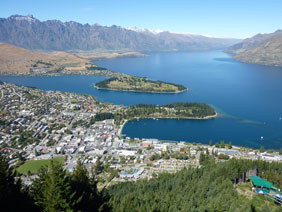Panasonic Lumix DMC-TZ7 / ZS3
-
-
Written by Gordon Laing
Panasonic TZ7 / ZS3 vs Canon 100IS / SD780IS vs Fuji F60fd Resolution
Panasonic Lumix DMC-TZ7 / ZS3 |
Canon IXUS 100 IS / SD780 IS |
Fujifilm FinePix F60fd | ||
 |
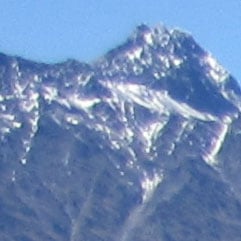 |
 | ||
f5, 80 ISO |
f10, 80 ISO |
f5, 100 ISO | ||
 |
 |
 | ||
f5, 80 ISO |
f10, 80 ISO |
f5, 100 ISO | ||
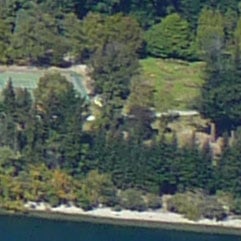 |
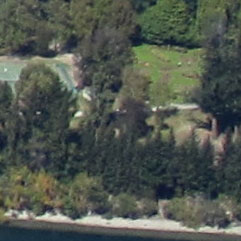 |
 | ||
f5, 80 ISO |
f10, 80 ISO |
f5, 100 ISO | ||
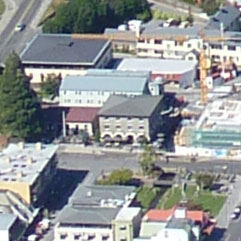 |
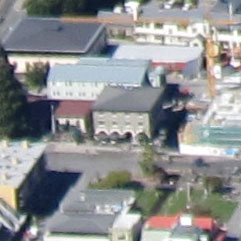 |
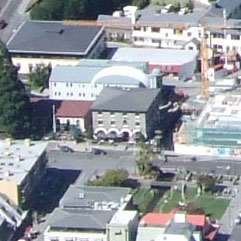 | ||
f5, 80 ISO |
f10, 80 ISO |
f5, 100 ISO |
To compare the optical performance of the camera when fully zoomed-out, we shot this scene with the Panasonic Lumix TZ7 / ZS3 using its widest focal length – an equivalent of 25mm. As before, we used the best quality JPEG settings, lowest sensitivities and default processing options. The camera was set to Normal recording mode – fully automatic, but allowing adjustment of the sensitivity. The image to the left was taken with the Panasonic Lumix TZ7 / ZS3 at a sensitivity of 80 ISO, and the lens set to 4.1mm (25mm equivalent), f4.5; the original 10M Fine JPEG file measured 5.5MB. The crops are taken from the upper left, centre and lower right, and are presented here at 100%. The crops below reveal an impressive consistency across the frame when fully zoomed-out. Despite the fairly extreme wide-angle coverage, the TZ7 / ZS3 maintains respectable sharpness into the corners with no undesirable optical artefacts to mention (although we believe the camera is applying software correction to coloured fringing). None-the-less, an excellent result here for the Lumix TZ7 / ZS3. Now scroll down to see how the camera measures-up when fully zoomed-in. |
Panasonic Lumix DMC-TZ7 / ZS3 wide angle performance: 100% crops | ||||
 |
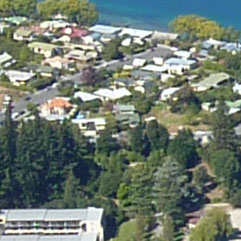 |
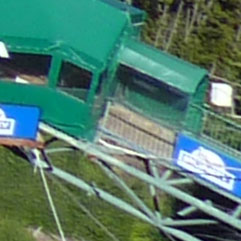 | ||
f4.5, 80 ISO (top left crop) |
f4.5, 80 ISO (middle crop) |
f4.5, 80 ISO (bottom right crop) | ||
To compare the optical performance of the camera when fully zoomed-in, we shot this scene with the Panasonic Lumix TZ7 / ZS3 using its longest focal length – an equivalent of 300mm. As before, we used the best quality JPEG settings, lowest sensitivities and default processing options. The camera was set to Normal recording mode – fully automatic, but allowing adjustment of the sensitivity. The image to the left was taken with the Panasonic Lumix TZ7 / ZS3 at a sensitivity of 80 ISO, and the lens set to 49.2mm (300mm equivalent), f5.6; the original 10M Fine JPEG file measured 5.61MB. The crops are taken from the upper left, centre and lower right, and are presented here at 100%. Like most super-zooms, the Lumix TZ7 / ZS3 suffers from a reduction in contrast when fully zoomed-in, although it’s not that bad here at all. The upper left corner has become a little soft and there’s minor evidence of coloured fringing in all corners, but again it’s not that bad. Considering the broad focal range and small form factor, the Lumix TZ7 / ZS3’s optics really are performing very respectably in these tests. You can see more real-life examples across its focal range in our Sample Images Gallery, or alternatively to see how the camera compares in terms of high sensitivities, then head over to our Panasonic Lumix DMC-TZ7 / ZS3 High ISO Noise results. |
Panasonic Lumix DMC-TZ7 / ZS3 telephoto performance: 100% crops | ||||
 |
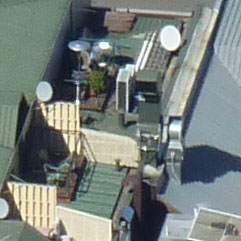 |
 | ||
f5.6, 80 ISO (top left crop) |
f5.6, 80 ISO (middle crop) |
f5.6, 80 ISO (bottom right crop) | ||
|
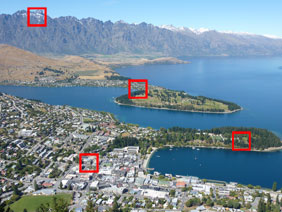 |
To compare real-life performance we shot this scene with the Panasonic Lumix TZ7 / ZS3, Canon IXUS 100 IS / SD780 IS and Fujifilm F60fd within a few moments of each other using their best quality JPEG settings, lowest sensitivities and default processing options.
The lenses on each camera were adjusted to deliver the same field of view, as much as their coarse zoom steps would allow. Each camera was set to an Auto mode with ISO override; note the Panasonic and Canon models here offer no control over the aperture.
The image above was taken with the Panasonic Lumix TZ7 / ZS3 at a sensitivity of 80 ISO, and the lens set to 6mm (37mm equivalent), f5; the original 10M Fine JPEG file measured 5.59MB. The crops are taken from the areas marked by the red squares, and are presented here at 100%. The Lumix TZ7 / ZS3 crops show a slightly larger area because of its slightly lower effective resolution than the other two models on test here. Note: with only two apertures to choose from, the Canon automatically selected the smaller of the two for this shot – there’s no way to manually override this setting.
The Canon and Fujifilm models on test here boast two additional Megapixels over the Panasonic Lumix TZ7 / ZS3, and also apply greater sharpening with their default settings. Sharpening aside, the Canon and Fujifilm genuinely manage to resolve a little extra real-life detail, although only where their optics are working at their best. This is most noticeable in the second row of crops where there’s less fine detail on the Panasonic crop.
But, and it’s a big but, the Panasonic Lumix TZ7 / ZS3 delivers more consistent results across the frame than the other two models on test here. Each of its four crops share similar degrees of optical performance, whereas the other two models suffer in certain areas. Our sample of the Canon in particular performed very poorly in its lower left area, becoming quite soft despite the rest of the frame looking great.
This is an impressive result for the Lumix TZ7 / ZS3 considering it has a 12x optical zoom and the other two only have 3x ranges (neither with true wide angle either). So while a 12 Megapixel compact could potentially out-resolve the TZ7 / ZS3, it’ll only do so if its optics also measure-up.
This test just considers one focal length though, relatively close to the wide end of the scale, so lower down this page, we’ve taken a closer look at how the Lumix TZ7 / ZS3’s lens performs when fully zoomed-out and fully zoomed-in. Check it out by scrolling down, but if you can’t wait to see how the cameras compare in terms of high sensitivities, then head straight over to our Panasonic Lumix DMC-TZ7 / ZS3 High ISO Noise results.
UPDATE: We have new comparisons between the TZ7 / ZS3 and Canon’s PowerShot SX200 IS here.
